VW Spec AD Posted with Behind The Scenes Video
[vimeo video_id=”12056425″ width=”700″ height=”398″ title=”Yes” byline=”Yes” portrait=”Yes” autoplay=”No” loop=”No” color=”00adef”]
A few months ago Canon came to me asking if we could do a shoot together that demonstrated the unique capabilities of their newest HDDSLR cameras – in this case the Canon 1D Mark IV. We decided to shoot a spec ad for the VW Bug. It was shot over two days in downtown Los Angeles with a Canon behind-he-scenes crew on site that documented each step along the way.
Today, I am happy to be able to share the final product with you, as well as a link to the Canon Digital Learning Center. Canon has just published the first installment of their behind-the-scenes series on this project, and are planning on releasing a new episode each week for the next five weeks.
Following my initial shoot with the 1D Mark IV on “Nocturne” – which highlighted the camera’s incredible low light performance – I decided to explore another facet of its capabilities with this project. I wanted to show how the camera could perform on a multitude of platforms – in this case the Filmotechnic crane mounted to a car. I really wanted to see how this camera would work on the crane when connected to the zoom and focus controllers and live feed – confirming that Canon HDDSLRs could drop into a system designed to house motion picture cameras and pull off the same cinematic results. Another goal was to show that the camera performs well while in motion and with moving subjects, and I found that 1D Mark IV has significantly corrected the “jell-o effect” relative to the 5D Mark II.
While the “jell-o effect” exists with any CMOS sensor given their design, I didn’t find it to be a factor in this project – or for that matter – or on any of my other productions. Its important to keep in mind that any camera out there, film or digital has limitations on how fast you can pan it – especially when projected onto a large screen. In general, a DP will always plan for this on any camera moves they are directing the speed of the camera’s move. It’s important to remember that a pan may look just fine on a 17″ monitor – but the same pan may be a bit painful for the audience’s eyes on 50 foot silver screen. Unless you are doing dynamic and fast moving action sequences, where you are purposefully moving the camera at extremely high rates (whip pans, running sequences, etc.), I would say its unlikely you will encounter issues with the “jell-o effect”. In the end its the DP’s responsibility to know the strengths and weaknesses of their tools, and to make sure they know how to shoot around those limitations.
Aside from finding there were no issues with camera motion, it was great to see the Canon 1D Mark IV fall right into place on the Filmotechnic crane. We fit a Preston motor on both the zoom and the focusing rings of the 24mm-105mm and found it performed flawlessly – of course our 1st A.C. also did a fantastic job of keeping things in focus. We shot everything at an aperture of f5.6 – the lens is an f4 lens throughout the focal range – because it gave us an extra stop’s worth of depth of field and the look we were going for when combined with the super35mm sized sensor. A Blackmagic converter box – mounted on and powered by the crane arm -allowed us to convert the HDMI signal to HDSDI, which in turn allowed everyone inside the car to get a live image (the 1st A.C. in the trunk, me at the controls of the pan and tilt head, the crane operator in the backseat, and the 1st A.D. sitting up front, coordinating the car to car communication and with the police motorcycle escort as well). The whole system delivered fantastic results. I should say that operating such an arm should be on every DP/ director/operator’s bucket list. It was incredibly cool (see video here) – and good to know that all those hours on the XBOX and flight simulator joysticks finally came in use.
If you want to check out video of how this was done, and more, please visit Canon’s Digital Learning Center by CLICKING HERE. Some snapshots from the Canon site below:
Tags: 1D Mark IV, Canon, Digital Learning Center, Filmotechnic, Vincent Laforet, VW


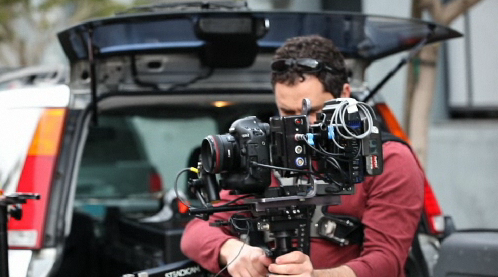
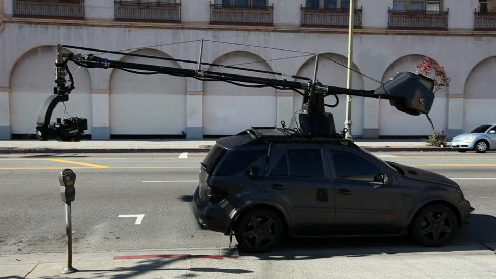

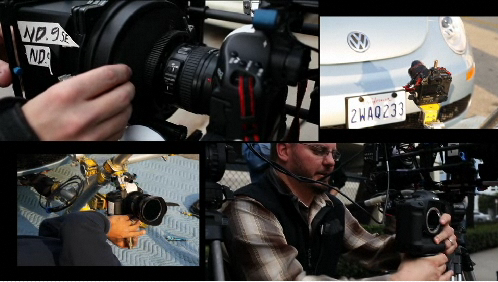

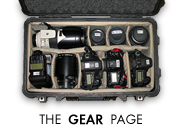

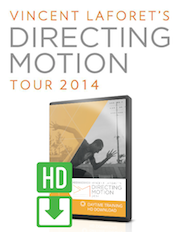








That is really interesting, Vincent.
I’ve seen that blog post before where you told about that crane on the car and I was really excited to see the outcomes.
Thanks for sharing all this,
I just can’t get enough of it 🙂
-Sebastian
Cool. Thanks for your input Vincent! I agree that it’s the DP’s responsibility to know the strengths and weaknesses of each format/camera. Best.
PS. The spec looks great! Reminds me of Herby. 🙂
Ahah! funny ending. Thanks for sharing how the clip has been done on the Canon’s Digital Learning Center. 🙂
ps: XBOX really helped? 😀
Great shots and thanks for providing all the background with gear for the rest of us.
Great stuff. But, I’ve always though that the HDSRL revolution was so cool because you can achive great image quality with a minor cost (the body of a 5d or a 1d I think is the cheapest part in your project), my question is: if the production is so big to provide you (not referred to YOU Vincent but to ANY DP) those expensive toys such as a last gen. crane on a Mercedes, the crew, the assistance of police, WHY use a HDSRL instead of a REDONE or a 35mm film camera?? In this particular case all has been sponsored by Canon (god bless them) but in the real world (film production, not spot or tv show) I think that the priority is given to the image quality, the 5d is good, but the film is on another planet. All IMHO of course!!
Vincent Laforet Reply:
June 2nd, 2010 at 1:57 am
@Mattia, All of these are very good points and questions to ask! My answer – the 5D can do some amazing things on no to low budgets. It cannot however defy the laws of good camera support and superior tools to pull off complex moves. The point of doing this project was to see how it performed. According to the experienced crew – we were able to shoot so much more quickly and achieve so many more shots that w/ other cameras. And the production was a FRACTION of the cost of what a film based shoot would be… has I shot this for VW as a real spot – I might have used fancier tools and perhaps even film – why not? The point is – I did not have CLOSE to that budget… and was still able to pull something off that’s quite decent. Is film on another planet – sometimes. Is the cost of shooting this on film vs digital greater – yes for sure on many levels. Film, processing are higher – but the post is another story entirely as you know – the post on a film shoot from this project would have dwarfed our entire production budget…
Vincent, I feel myself stupid. Can’t understand where were camera in this shot: http://www.usa.canon.com/content/laforet_mark_iv/files/images/highRes/Laforet_MarkIV_VW05.jpg
I think there must be reflections of camera in windows, but there aren’t. How? Or it’s post production?
Vincent Laforet Reply:
June 2nd, 2010 at 12:47 pm
@Rodion, I’m shooting from the front passenger window – with black duvetyne hanging so you can ‘t see my reflection 😉 Only the lens is sticking through a hole we made in the fabric.
Would you compare the the refresh rate (rollng shutter) on the 1dmk4 1080P to be comparable or faster than the 7d at 720P?
Cheers
Vincent Laforet Reply:
June 3rd, 2010 at 1:25 am
@Jeff Scholl, I think they’re similar. I haven’t done side by side test – I’ve simply compared the 5D MKII to the 1D MKIV – both of which I use regularly. Sorry not to have a better answer.
Wow this looks great! So do you have a preference (overall or on different levels) for the 1d MkIV over the 5D when suitable?
vincent,
what happened to the video you shot at night (or did you not shoot more at night)? looked like you had shot more when it was dark out on the canon website but the final commercial only had maybe 1 quick scene once the sun went down. was the footage not good or did it just not fit the theme of the commercial?
ciao,
mike.
Vincent Laforet Reply:
June 3rd, 2010 at 1:26 am
@mike malto, It just didn’t it the theme – we couldn’t cut it in saddly… going from dawn to day to dusk would have taken too much time…
Great job! Love the effects and use of motion. This must have been a great experience for you to complete so successfully.
Nice article!!
i love using filmotechic or russian arm or pursuit system. they are all solid, cost effective (on a full commercial budget of course) solutions to car to car shooting. i would say thought that most directors do not operate, unless they are a director/cameraman. which is rare in full budget jobs. very cool that you got the chance to experiment.
Vincent,
I bought your Creative Live workshop and have learned a lot and havepurchased essential equipment from B&H. However, I simply am not sold on HD DSLR technology. Sure, it allows people to make videos that would have cost a huge amount more two years ago, but I have not seen anyone doing Jean-Luc Godard level work with it for instance. You seem to mainly be doing commercial work now. It is slick and looks good but is it important, serious work? I come from the Magnum tradition of doing socially important photography. Your videos all seem to be for companies: fulfilling a client’s need as opposed to creating ART.
Who paid for the Mercedes SUV AMG?! Why was it an AMG?! A Mercedes alone is nice, but an AMG?! Wow! Canon I guess can pay for anything.
Xaria Reply:
April 10th, 2011 at 8:02 pm
RJpf4G Kudos to you! I hadn’t thought of that!
Hi Vincent,
I am considering purchase of a Kessler crane. Looking for an affordable way to remotely control focus/zoom.
Preston seems a bit out of my league… as probably any motorised solution. Should I wait for the USB connected remote from Viewfactor for Canon USM glass?
Cheers.
Richard
On one hand I think that Vincent is is quite talented and useing the Canon cameras to thier max.
But on the other hand i think that the basic user of the 1Dmark4 can’t really afford all the equipment Vincent has access to. I would like to see Vincent get back to basics as he did in his first DSLR video (which was brilliant)and really show that it is the user not the camera that makes a great photographer.
I would also like to see sports video that uses a mix of stills and video from the mark4. No lights, no production, no set-up. just show us what the camera and more importantly what the photorapher can do.
Just my 2 cents.
Thanks
Michael
When can we expect the final two installments on Post & Delivery from this series?
Vincent, I just want to say a big thanks for sharing. It’s a huge help having access to this sort of information, and an inspiration to see the quality of the work you’ve done.
Good experience, Thanks for the clip.
Hello. I hope you dont mind me posting on your blog. I wanted to contact you but I cannot find your contact info. I want to subscribe to your blog for updates but I cannot find your RSS subscription link. Please assist. Thanks.